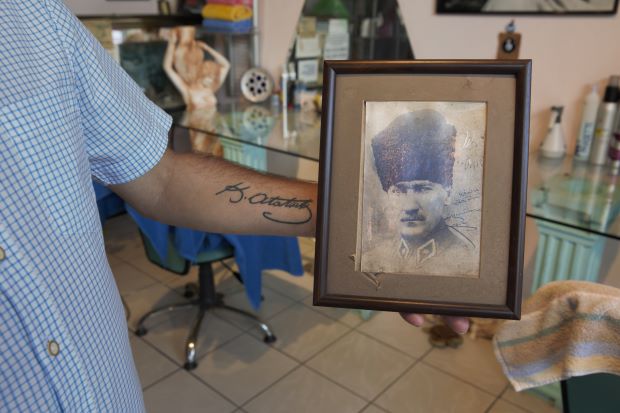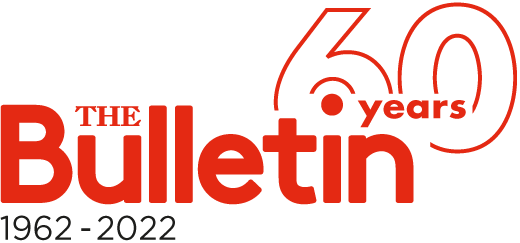- Daily & Weekly newsletters
- Buy & download The Bulletin
- Comment on our articles
House of European History: A photographic survey of a shared past
How do people see the past and how can history and historical events help us to do so? This is a key question at the heart of the House of European History (HEH)’s first photographic exhibition, Presence of the Past. A European Album.
Bringing together more than 100 works by some 30 photographers including Roger Cremers, Nick Hannes and Michael Pappas, it is divided into seven sections exploring different types of engagement and motivation, including ‘Destination history’, ‘Post-heroic commemorations’ and ‘Hero-making’.
“Europeans engage personally with the past, in many ways and for many reasons, from processing grief and reconciling with past tragedies to entertainment and escape from the banality of everyday life,” explains museum director Constanze Itzel.

Bringing history firmly up to date, six students of La Cambre photography school provide a counterpoint to the themes. Visitors can leave their mark on the show by selecting, labelling and displaying old photographs as well as responding to questions such as ‘’Do historical sites belong to the living or to the dead?”
The free museum boasts a photography connection as the original Art Deco building in Leopold Park was commissioned by US philanthropist Georges Eastman, who co-founded the Kodak photography company. The former dental clinic for disadvantaged children underwent major renovation before opening in 2017 as a European project contributing to an understanding of Europe’s shared past.

Striking works in the first section show how tourism has transformed the past into something that can be visited – and endlessly photographed with a mobile phone. It does not seem possible that the horrors of Auschwitz-Birkenau concentration camps can be envisaged as a happy day out, but that is the impression given by Roger Cremer’s Teenagers at the monument between Birkenau crematoria II and III.
“People mobilise all kinds of defence and distancing strategies when confronted with shock,” says curator Stéphanie Gonçalves, but it is “nevertheless irritating to see groups of visitors at Auschwitz seemingly routinely taking group photos.”

Other arresting images of Pamukkale, Turkey, by Nick Hannes, include a bikini-wearing woman simpering and making the victory sign to the camera in Tourists to ancient Hierapolis, a UNESCO World Heritage Site. Glistening red bodies are on display in his Tourists bathe in ‘Cleopatra’s pool.
“The historical site takes on the allure of an amusement park,” says Hannes of these now commercialised places. But Véronique Ellena accords dignity to the homeless sleeping outside classic Italian monuments in Rome, in her series Les Invisibles: Santi Luca e Martina.

Another form of historical holiday is participating in re-enactments. These are rife in Belgium, from anniversary commemorations of the 1815 Battle of Waterloo to medieval fairs complete with jousting, crafts and camp life. Photos by Roger Cremers highlight Europeans’ fixation on the Second World War (pictured, main image), while Petruț Călinescu portrays the joy of being a Dacian – the ancient warrior population considered the ancestors of today’s Romanians and Hugo Passarello Luna illustrates a desire to take refuge in the past with his First World War project Nostalgia for Mud.

Europeans have endlessly made heroes of religious and political leaders as well as sporting heroes. Mine Dal portrays Mustafa Kemal Atatürk, the founder of modern Turkey, in anything from cemeteries to the local boulangerie in her series Everybody’s Atatürk. She looks at the same posters set 20 years apart to show that, “in Turkey, everything changes but Atatürk”.
A cult around John Paul II sprung up in Poland after his death in 2005; new monuments to the late pope were unveiled almost weekly. Michela Cane photographed the myriad posters and images of Argentinian footballer Diego Maradona across Naples, a city which enhanced its reputation thanks to the player who repeatedly led his club to victory.

Fame and fortune are shown to be sometimes fleeting, notably in the removal of communist-era symbols in states like Bulgaria and Ukraine. Niels Ackermann’s striking, gold A headless Lenin sculpture, Shabo, Ukraine, is one example from his project with journalist Sébastien Gobert documenting the fate of Lenin’s statues in Ukraine since 2015. He also photos Lenin heads bundled into a car (pictured above) to be sold in support of Russian separatists, with Ukrainians despairing that, “Our history will disappear, sold for just a few dollars,” comments Gonçalves.
Today, controversy continues over statues erected during the reign of Léopold II, who exercised a ruthless colonial regime in the Congo. Ria Pacquée’s mesmerising 2022 video, Washing Away the Past, Ostend, shows one red paint-sloshed monument being cleaned up. A nearby slogan proclaims that “53% think we should honour our past heroes, even if their views do not reflect those of today”.

The exhibition concludes with a focus on the need to collect, preserve and archive the past – and not just on a mobile phone – to document the wonders and horrors of the past. It also invites viewers to create their own personal history.
Presence of the Past is accompanied by a programme of events including guided tours, films, talks, workshops, children’s activities and a ‘Picture It’ photo participatory project, where visitors are given a disposable Kodak camera to create a work that will be displayed in the exhibition later in the year.
Presence of the Past. A European Album
Until 11 January
House of European History
Free and open daily (Monday from 13.00)
Rue Belliard 135
Brussels
Photos: (main image) ©Roger Cremers, Preparing for a Second World War re-enactment event in Ursel, Belgium; ©Nick Hannes, Des touristes à Hiérapolis, un site classé au patrimoine mondial de l’UNESCO, Turquie; ©Petruț Călinescu, Dacian re-enactment at Cucuteni archaeological site, Romania; Mine Dal, A portrait of Atatürk and a tattoo of his signature, Türkiye; ©Niels Ackermann, Lenin ‘trophies’ being sold to help fight Russia-backed separatists in Donbas, Ukraine



















